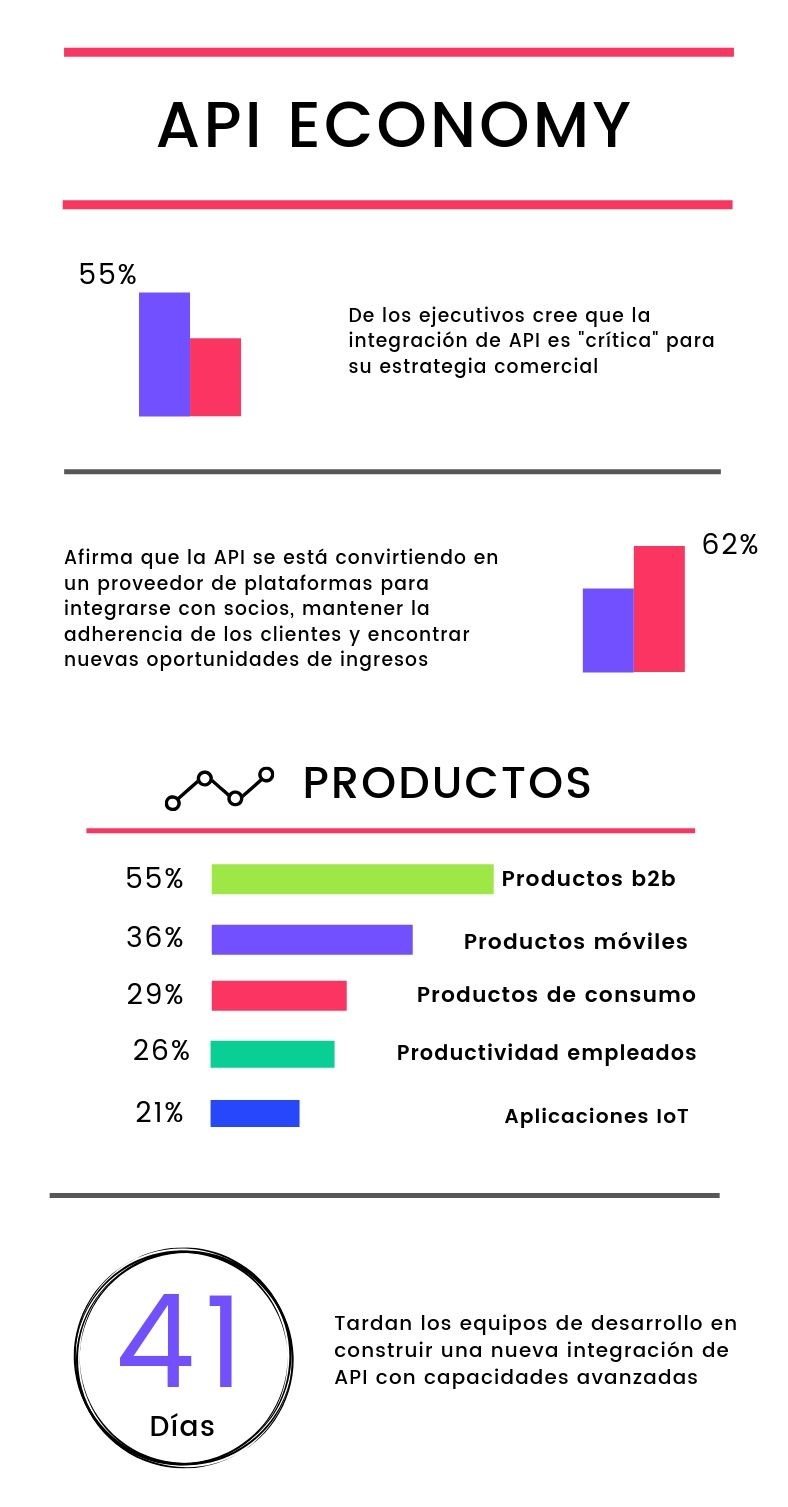A 55% companies use APIs as a revenue stream

In modern software development, communication between multiple applications is essential to build a robust developed ecosystem and, in turn, a seamless digital experience for customers. Individual platforms based on web application programming interfaces (APIs) are described as the “glue that holds the Web together” and are the ones that allow a standard mechanism to share data and functionality and therefore have fluid communication.
As APIs become increasingly ubiquitous, many executives wonder how they can gain a competitive advantage. According to a recent report, 35% of today’s technology leaders generated more than a quarter of their organizations’ revenue as a direct result of APIs.
The state of the Api-economy
Many companies already see the need to create a developer-oriented business model, according to the latest reports 55 companies use APIs as a revenue stream. Programmable Web, the world’s largest public API directory, has cataloged more than 21,000 public APIs.

For example, the company Helix, specialized in the field of health, bases its services on simple genetic tests that users can carry out at home, without prior knowledge. It provides its genome testing service as a service that can be integrated into their own products by other companies such as National Geographic or Mayo Clinic.
It can be said that Helix has based its business model on an API so that other companies can incorporate this service into their own offering. Facilitating the heavy lifting of analyzing DNA testing and data management.
For most, if not all organizations, the API economy proves to be a viable way to create new services and capabilities, ultimately leading to new revenue streams. With the addition of the popular APIs and services that use them, organizations will make APIs an important factor in their business model.
Right now, more companies than users have an API-based business model.
- Google has over 92 APIs available, including Google Maps, Analytics, Calendar, Contacts.
- Twitter uses APIs to expand its business, creating one of the most popular APIs on the internet. Although it is currently restricting its API policy.
- Facebook, Spotify or Paypal are mainly API-based, connecting their services to millions of third-party websites and apps.
- The Idealista website provides an API focused on facilitating the sale/rental of properties, with the main objective of being able to estimate the price of land in the different locations and neighborhoods.
- The world’s leading publishing company Pearson also has an API Economy, allowing to make a plug&play of its services to reach more audiences.
- Japanese multinational Sony has an API for developing applications integrated into their devices. The more developments you have in this environment, the more attractive it will be for your customers to decide on Sony devices or some of their competitors.
In the past, APIs were primarily relegated to software professionals looking to solve data exchange issues and interfaces associated with incompatible software solutions. Over time, however, the increase in API value has become apparent, exemplifying the possibilities of emerging technologies.
These technologies, such as social networks, web-based applications, mobile solutions and countless other efforts, have fully demonstrated the emerging financial benefits that APIs offer businesses along with the ability to earn additional revenue.
The obstacles
Despite its boom there are several key obstacles that companies must overcome to obtain the benefits of API-based solutions
The biggest is standardization. Flexibility is one of the main strengths of API technologies, however, as developers look for tailored solutions for specific business problems, this flexibility can generate inconsistencies in API business specifications and identity and security frameworks. needed to access the APIs reliably.
Regulatory specifications also differ across the world, and individual financial institutions often have significant room to maneuver to interpret them. This fragmentation requires companies to develop different solutions for each market in which they operate: a clear cause of inefficiency and an impediment to global adoption at scale.
For large organizations with a significant legacy, it can be particularly difficult to implement API-based solutions without major risks or interruptions. Therefore, for the leaders of the predominant market, the challenge is to unlock the transformative change in an environment that prioritizes stability over agility.
This can be solved thanks to companies such as SWIFT, which from its position as an industry standard setter can provide a neutral forum for collaboration towards consistent API standards.

Workflow optimization
Once the obstacles that must be overcome are isolated, it is convenient that the organizations have a well organized and agile IT department, since it will be the one that allows the integration of the API to take place successfully.
The strategy for managing the API must become a real platform: a self-service platform that allows commercial departments to easily provide and consume services. For that, the IT department will provide an API, along with the processes and tools, making sure that everything is protected and implemented in a controlled manner.
The main objective of a business API management platform is to make internal and external services discoverable by providing a centralized API Catalog. This allows commercial departments, for example, to find an existing integration in an application in the cloud and combine that data into their own projects.
However, you can only discover on the platform, what has been previously registered. Therefore, the self-service processes for the provided API service are very important for the success of the API administration platform.
Do not forget that APIs can address previous IT systems. To address the inherited barriers, it is not necessary to eliminate and completely replace the entire system.
An example is Suncorp, a bank insurer that took digital transformation to the next level. Suncorp changed its business strategy, focusing on customer-centered needs. Building more than 400 API to join all its brands that are part of the company. For this, they used a management platform that allowed them to go through an automated test regime.
Conclusions
With an increasing number of APIs, it is difficult for developers to keep abreast of all the changes that happen So far, a solid and lasting basis for innovation has been created, but more is needed.
More technologies and integration patterns, in addition to security to increase confidence. New standards to help interoperability, along with more analysis to inform decisions. Without forgetting new tools that help facilitate integration along with more governance to manage complexity.


